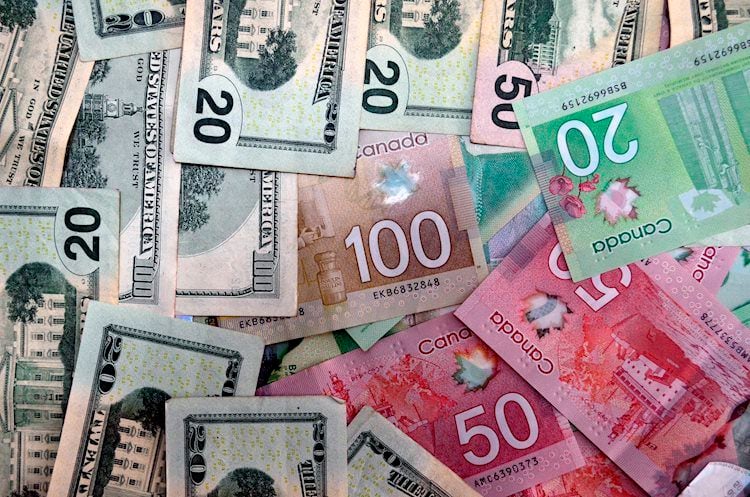Jobs
USD/CAD extends upside to near 1.3750 ahead of US PPI, Canadian job report

- USD/CAD trades in positive territory for eight consecutive days near 1.3745 in Friday’s early Asian session.
- The US CPI inflation was hotter than expected in September; Jobless Claims jump to a year-high
- The Canadian Unemployment Rate is estimated to rise from 6.6% in August to 6.7% in September.
The USD/CAD pair extends the rally to around 1.3745 during the early Asian session on Friday. The hotter-than-expected US inflation data and hawkish comments by Federal Reserve (Fed) officials provide some support to the Greenback ahead of the US September Producer Price Index (PPI) and Canadian job data.
The US inflation was higher than forecast in September, while jobless claims posted an unexpected jump. Data released by the US Department of Labor Statistics on Thursday showed that the Consumer Price Index (CPI) rose 2.4% YoY in September, compared to 2.5% in August. The figure came in above the consensus of 2.3%. The core CPI, excluding food and energy, climbed 3.3% YoY in September, above forecast and the previous reading of 3.2%.
Meanwhile, the US Initial Jobless Claims for the week ending October 4 rose to 258K, up from the previous week’s 225K. The figure was above the initial consensus of 230K.
Though the inflation reading was hotter than expected, traders in futures markets increased their bets that the Fed would lower rates by 25 basis points (bps) in the November meeting, pricing in nearly 86%, according to the CME FedWatch Tool.
On the Loonie front, the Canadian job report will be published later on Friday. The Unemployment Rate is projected to rise from 6.6% in August to 6.7% in September. The rising unemployment rate and easing inflation to the target range might trigger the faster and larger interest rate cut from the Bank of Canada (BoC). This, in turn, exerts some selling pressure on the Canadian Dollar (CAD) and acts as a tailwind for the USD/CAD pair.
Canadian Dollar FAQs
The key factors driving the Canadian Dollar (CAD) are the level of interest rates set by the Bank of Canada (BoC), the price of Oil, Canada’s largest export, the health of its economy, inflation and the Trade Balance, which is the difference between the value of Canada’s exports versus its imports. Other factors include market sentiment – whether investors are taking on more risky assets (risk-on) or seeking safe-havens (risk-off) – with risk-on being CAD-positive. As its largest trading partner, the health of the US economy is also a key factor influencing the Canadian Dollar.
The Bank of Canada (BoC) has a significant influence on the Canadian Dollar by setting the level of interest rates that banks can lend to one another. This influences the level of interest rates for everyone. The main goal of the BoC is to maintain inflation at 1-3% by adjusting interest rates up or down. Relatively higher interest rates tend to be positive for the CAD. The Bank of Canada can also use quantitative easing and tightening to influence credit conditions, with the former CAD-negative and the latter CAD-positive.
The price of Oil is a key factor impacting the value of the Canadian Dollar. Petroleum is Canada’s biggest export, so Oil price tends to have an immediate impact on the CAD value. Generally, if Oil price rises CAD also goes up, as aggregate demand for the currency increases. The opposite is the case if the price of Oil falls. Higher Oil prices also tend to result in a greater likelihood of a positive Trade Balance, which is also supportive of the CAD.
While inflation had always traditionally been thought of as a negative factor for a currency since it lowers the value of money, the opposite has actually been the case in modern times with the relaxation of cross-border capital controls. Higher inflation tends to lead central banks to put up interest rates which attracts more capital inflows from global investors seeking a lucrative place to keep their money. This increases demand for the local currency, which in Canada’s case is the Canadian Dollar.
Macroeconomic data releases gauge the health of the economy and can have an impact on the Canadian Dollar. Indicators such as GDP, Manufacturing and Services PMIs, employment, and consumer sentiment surveys can all influence the direction of the CAD. A strong economy is good for the Canadian Dollar. Not only does it attract more foreign investment but it may encourage the Bank of Canada to put up interest rates, leading to a stronger currency. If economic data is weak, however, the CAD is likely to fall.









